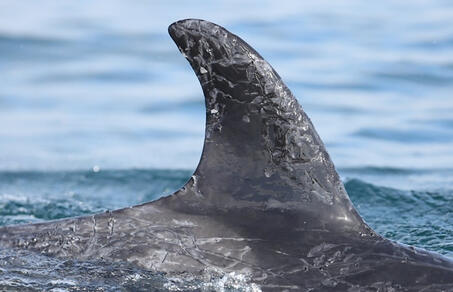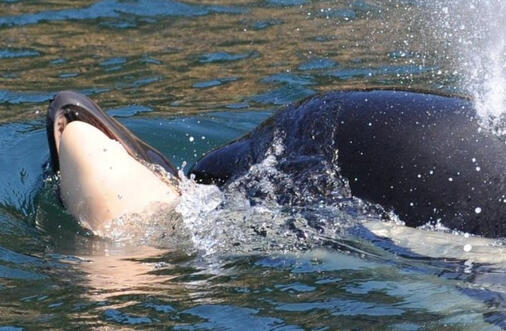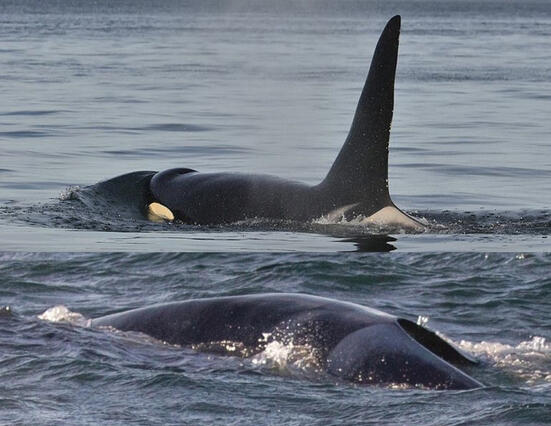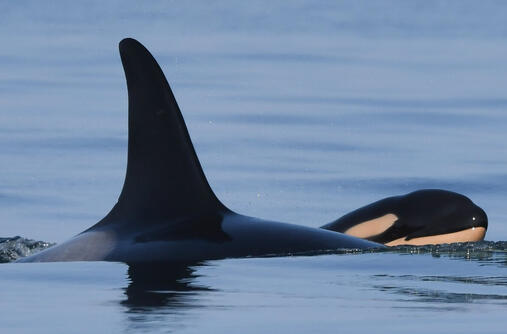THE SOUTHERN RESIDENT ORCAS ARE BEING DAMMED TO EXTINCTION
#NOFISHNOBLACKFISH #FREETHESNAKE
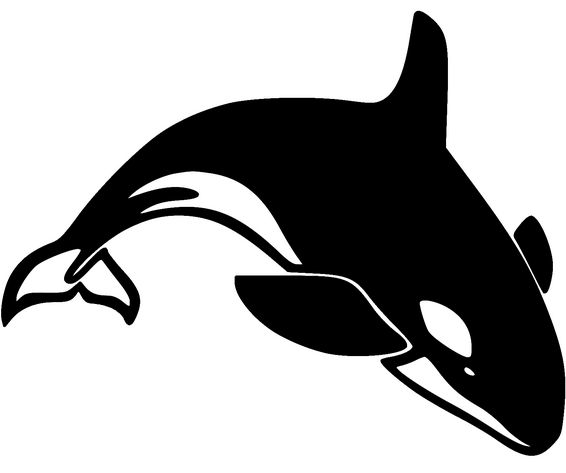
The Southern Resident killer whales (SRKW) are a population of fish-eating killer whales that live in the Pacific Northwest. Their main source of food is the Snake River Chinook Salmon. Unfortunately, due to 4 hydropower dams in the lower region of the Snake River- Ice Harbor, Lower Monumental, Little Goose, and Lower Granite- the salmon that the Southern Residents rely on have nearly gone extinct. Every year, young salmon migrate down the Snake River from their birthplace in Idaho to the Pacific Ocean, where they will grow and eventually breed. Before the salmon reach the sea, however, they must pass through the Lower Snake River dams, where over 98% of them are killed. With their main source of food almost completely gone, the Southern Resident population has declined rapidly. Although there were once hundreds of Southern Residents, as of May 2022 there are only 75 living Southern Residents remaining, and their population is only expected to decline even further. Due to a lack of food, at least 70% of Southern Resident pregnancies fail, and less than 25% of calves survive to adulthood. If nothing is done to help them, the Southern Residents will become functionally extinct by 2035. The lower Snake River dams generate almost no usable power, and they do not provide any flood control. These dams could easily be replaced with other forms of power generation, and once the dams are gone both the whales and the salmon are expected to recover rapidly. We still have time to save the salmon- and the whales- but we need to act now. __We need to breach the lower Snake River dams before it's too late. __
BREAKING NEWS: The United States Council on Environmental Quality is currently taking public comments (link) on the impact of the dams on the Columbia River Basin, and on breaching the four lower Snake River dams. THIS IS OUR CHANCE TO BE HEARD! A sample email can be found here, and contact information can be found here. Let our lawmakers know that it's time to breach the dams!
How You Can Help
Learn More
last updated on 06/25/2022 - contact us or leave site feedback here
#NOFISHNOBLACKFISH #FREETHESNAKE

L25 "Ocean Sun", who is believed to be over 90 years old. She is the oldest living Southern Resident, as well as the only living Southern Resident over the age of 60. Photo Credit: Andrew Reding
contact us!
last updated on 06/25/2022 - contact us or leave site feedback here
#NOFISHNOBLACKFISH #FREETHESNAKE

J50 "Scarlet", who was dubbed the "happiest whale in the world" in 2016. She died in September of 2018. Photo Credit: Clint Rivers
the Southern Residents & THE Lower SNAKE RIVER DAMS
The Southern Resident Killer Whales are a population of killer whales that live in the Pacific Northwest, primarily in the Salish Sea. Their diet consists almost entirely of Chinook salmon. Unfortunately, the Chinook salmon are dying out- and so are the Southern Residents. There are currently just 75 of these precious whales left. The nutritional stress caused by a lack of food means that many of these whales develop health issues and die young, and that most pregnancies end in failure. At least 70% of pregnancies are unsuccessful, and a majority of calves do not make it to adulthood.The Snake River, where the salmon that the Southern Residents rely on come from, is the most well-preserved salmon spawning habitat in the continental United States. The river once saw annual salmon runs consisting of over 100,000 fish. Now that number is less than 10,000, and salmon survival rates are just 0.35 - 2%. This is because of 4 hydropower dams located in the lower Snake River- Ice Harbor, Lower Monumental, Little Goose, and Lower Granite. These dams kill the salmon as they travel to and from their spawning ground. The turbines on the dams kill young fish as they travel downstream, and the dams themselves create reservoirs of warm water that confuse and sicken the traveling fish. The Snake River Chinook salmon are considered endangered, and there have been multiple attempts to protect them. Federal taxpayers spend $550 million annually (and have spent over $18 billion in total) on various salmon recovery plans, all of which have failed.These dams generate very little usable energy, and most of the energy that they do produce is simply sold as surplus energy instead. It would be cheaper and more efficient to invest in other forms of clean power instead. These dams do not provide any type of flood control, and some of the dams even increase the local flood risk. Expensive construction is needed on at least one of the dams in order to reduce this risk.The cost of breaching the dams would be minimal compared to the current costs of salmon recovery and maintaining the dams. Dam removal would eventually even pay for itself through the revenue generated from successful salmon recovery. In similar situations, salmon populations recover very quickly after dams are removed. Scientists believe that, once the dams are gone, the Southern Residents will recover as well.Unfortunately, we are running out of time. Less than half of the population is able to breed, and less than half of the babies born in recent years have survived. The Southern Residents are expected to become functionally extinct by 2035, and completely extinct by the end of the century, if we do not act now.The overwhelming consensus among scientists is that removing the dams is the only way to make sure that the salmon- and ultimately the killer whales as well- recover. We need to breach the dams.
More Information
last updated on 06/25/2022 - contact us or leave site feedback here
#NOFISHNOBLACKFISH #FREETHESNAKE

J31 "Tsuchi" and her daughter, J56 "Tofino". Photo Credit: NOAA Fisheries, taken under NMFS permit #19091
Other Important Issues
Enviromental Issues
Indiginous Issues
last updated on 06/25/2022 - contact us or leave site feedback here
#NOFISHNOBLACKFISH #FREETHESNAKE
Why should I care?
Killer whales are extremely intelligent and emotional animals. Each population has their own diet, language, and culture. Killer whales live in groups of family members known as pods, and calves spend their entire lives with their mothers. Mothers pass down their languages and traditions to their calves. Pods care for their sick and injured members, mourn their lost family, and are even known to carry the bodies of deceased whales around for days. Here are just some of the heartbreaking stories of Southern Residents.
J52 "Dipper" covered in bite marks shortly before his death. Photo Credit: Kenneth Balcomb
In 2016, J28 "Polaris" passed away, leaving her 10 month old son, J54 "Dipper", behind. His 7 year old sister, J46 "Star", tried to keep him alive by bringing him fish to eat- but the lack of fish meant that she couldn't get him enough food to eat. He became delirious from illness and hunger, and he stopped swimming. Desperate to keep him alive, his sister would grab his body with her teeth and bring him to the surface to breathe. This lasted for days, and his body became covered in bite marks. Sadly, he eventually succumbed to starvation and illness and died.
J35 "Tahlequah" carrying her deceased daughter. Photo Credit: Center for Whale Research
In July of 2018, J35 "Tahlequah", a female killer whale, lost her calf just minutes after birth. The grief-stricken mother carried her daughter's body for over 1000 miles on a "Tour of Grief" that lasted for 17 days. The entire time she refused to leave her daughter behind, carrying the body even when she was visibly weak and losing weight.
How K21 "Cappuccino" looked when he was healthy (top) and when he was spotted in July 2021 (bottom). Photo Credit: Center for Whale Research and adventuresbyhip
In July of 2021, K21 "Cappuccino", a beloved member of the Southern Residents, became extremely sick. When boaters spotted him he was incredibly emaciated. His markings were pale, and he was so malnourished that his dorsal fin had fallen completely over. He was so weak that he couldn’t even battle the current and was barely able to keep himself upright. He passed away soon after, likely later that day.
J35 "Tahlequah" and her son, J57 “Phoenix”. Photo Credit: Katie Jones, Center for Whale Research
Thankfully, there is still hope for the Southern Residents. On September 4th, 2020, "Tahlequah" gave birth to a new calf, a son named J57 "Phoenix" by researchers. Only a few days later another calf, J58 "Crescent", was born to J41 "Eclipse". In January of 2021, L86 "Surprise!" gave birth to a daughter named L125 "Element". In February of 2022, J37 "Hy’Shqa" gave birth to a daughter named J59. In May of 2022, K20 “Spock” was seen with a newborn calf, K45. These births are incredibly important to the struggling population. With the dams in place, the chances of these calves surviving into adulthood are slim. In a population this small, every birth matters, and we need to protect these calves.
More Information
last updated on 06/25/2022 - contact us or leave site feedback here
#NOFISHNOBLACKFISH #FREETHESNAKE

J32 "Rhapsody", who died in late 2014 after she failed to expel a stillborn calf. Photo Credit: Miles Ritter
learn more
OTHER GREAT reSOURCES
